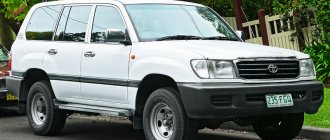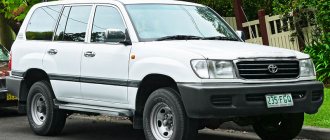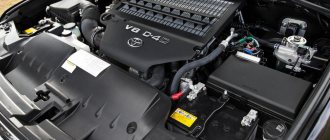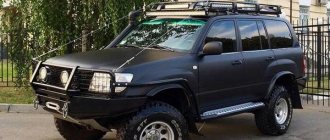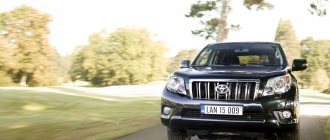For those to whom the Toyota Land Cruiser 200 and Land Cruiser Prado seem unattainable, it’s worth taking a closer look at the Toyota Land Cruiser 80. This car even has many advantages over modern Land Cruisers. This car first appeared in 1990, and then the 80th Land Cruiser made a splash in the world of off-road vehicles. Even though this car was released so long ago, it has comfort, excellent technical characteristics, and serious reliability.
Everything can be improved
The Land Cruiser 80 was at one time the largest SUV in the Toyota range. It’s difficult to call this huge car beautiful - due to the heaviness of its appearance (however, this can be called solidity). There are few cars that take up as much space on the road. But it’s not the appearance that makes an SUV beautiful, but its capabilities. Without trying to dispute the fact that the “eighty” can already do a lot of things off-road, we admit that everything can be improved.
This jeep will easily charm the off-road lover. The body is raised above the frame (lifted), large wheels with an all-terrain pattern are installed, and a snorkel is installed along the right pillar of the windshield. There is a large roof rack with additional rear-facing headlights. A ladder on the left half of the rear door, helping to climb onto the roof, is a must. The only thing missing is a winch. Or better yet, two.
Getting in and out is no problem: thanks to the large door openings, as well as the wide step.
Land Cruiser is a serious car, and this is easy to see once again by opening the hood. Everything that is possible is carefully sealed: all wiring is laid in special tubes; you will not see bare terminals on electrical connectors. For reliable engine starting in any weather, two powerful batteries are installed.
Utilitarian version
The interior is well designed and well finished. Every little detail has been thought through, everything you need is at hand. There is no pseudo-wood in the cabin - black plastic almost everywhere (by the way, none of the plastic parts bothered us with their “sound” during the test), no electronic “gadgets”. But this will not prevent a driver of any height and build from finding the optimal fit.
The doors are covered with ordinary leatherette. There aren't even the usual pockets for small items. There are two transmission control levers on the central tunnel, and on the console there is a button that locks the center differential. The manual transmission lever is located high, the shifts are clear.
The instrument panel has a large and easy to read speedometer scale. It is complemented by fuel level and engine temperature indicators. But there was no place for a tachometer. A very utilitarian version, it should be noted. Fortunately, at least there is air conditioning.
The back seat can comfortably accommodate three people, and if they squeeze in, there is enough space for a fourth (the car is almost two meters wide).
On the roads...
Connoisseurs and admirers of the Land Cruiser 80 do not need to be told about the phlegmatic nature of the 136-horsepower atmospheric diesel engine, which does not provide such a large car with good acceleration dynamics. An attempt at a sharp start showed that a Land Cruiser with a diesel engine, even with a manual gearbox, is not the best car for racing from traffic lights. But once it accelerates, the car confidently navigates city traffic. The wide range of torque came in very handy; even in fifth gear you can accelerate from 60 km/h.
At first, problems arise with the dimensions, especially during quick lane changes, however, after a while you realize that on such a car the tactics of “embroidering” the necessary fruits do not bear fruit. And there’s no point in it (not to mention the fact that it’s dangerous). You can simply move assertively in the left lane, rolling over those in front. Only the most “stubborn” driver will not clear the way when he sees a colossus hanging over the rear bumper.
It is noteworthy that the gearbox has close (for off-road use) gear ratios. When driving dynamically around the city, you have to work a lot with the lever. And on the highway, when the speed approaches 120 km/h, you can forget about switching, because the traction capabilities of the engine are quite enough to overcome most climbs in fifth gear.
Apparently, they worked seriously and thoroughly on the handling of the Land Cruiser 80. The car not only takes turns smoothly, but even encourages you to perform higher-speed maneuvers, despite its serious size and weight. In high-speed highway conditions, the Land Cruiser handles the road very confidently. A big part of this is the very precise steering feedback. The hydraulic booster is powerful, but the front drive wheels made it “transparent”. Even at speeds over 100 km/h, the reaction force on the steering wheel is noticeable.
You don’t have to worry about road surface defects thanks to the powerful, energy-intensive suspension. Even on serious potholes, the car only sways, as if noting their presence. The modernized suspension turned out to be quite long-travel and energy-intensive, although not very soft. Driving at various speeds and in different road conditions showed that the characteristics of the installed springs and shock absorbers were selected to ensure optimal vehicle behavior both on the highway, in the city, and off-road. Although especially ardent fans of high-speed off-road rides would benefit from having shock absorbers with adjustable stiffness. With their help, you can configure the suspension for high-speed driving on any road or off-road.
The “grumble” of a diesel engine can be heard from the moment the engine is started until its speed rises to approximately 3,000 per minute, only then does the diesel engine reduce its “bass”. The most painful thing from an acoustic point of view is a long drive in third gear at a speed of 60 km/h: the “grumble” of the engine begins to be downright annoying after just a couple of minutes.
Ride quality
The Land Cruiser 80 can travel at speeds of 160 km/h quite easily. But for those who like to drive fast, there is bad news - you will have to change the front axle after 100,000 km. In general, the axle beam is quite strong and reliable; you can easily install 32-inch wheels on it without resorting to a lift.
It is important to periodically look after the seals; they can leak due to clogged breathers and due to old age. The transmission here is mechanical , there is also a transfer case - they are not problematic at all, the rear axle, unlike the front axle, needs to be changed very rarely. There are configurations with an automatic transmission, which is also reliable and in most cases does not create problems for its owners.
... and without them
An important point when off-road is the type of tires used. In our case, the Land Cruiser was shod with off-road tires with large lugs. On the track, by the way, they behave somewhat worse than regular road tires.
It was not possible to find mud - the weather was disappointing (that is, it was very good). I had to jump along the gullies to “hang” the Land Cruiser at least diagonally. But it was not there. The upgraded suspension turned out to be very long-travel: despite all our efforts, the wheels never left the ground.
The Land Cruiser 80 is quite decisive off-road, so to speak. The lack of turbocharging, which leads to some despondency on the highway, made the engine extremely flexible: it never required downshifting. Moreover, even first gear in the main gearbox is only required when starting off.
And, of course, the suspension performs well on dirt roads. Expecting it to shake like a tractor, we were pleasantly surprised that the ride was quite tolerable.
Everything a Toyota Land Cruiser 80 buyer needs to know
Remember the old saying that in Russia there are no roads, but only directions. However, this can be said about many third world countries. Especially for such conditions, Toyota designed and launched the magnificent Land Cruiser 80 jeep in 1989. Fast on asphalt, invincible off-road... And even comfortable and reliable. A true land cruiser for any destination!
Everything a Toyota Land Cruiser 80 buyer needs to know
Remember the old saying that in Russia there are no roads, but only directions. However, this can be said about many third world countries. Especially for such conditions, Toyota designed and launched the magnificent Land Cruiser 80 jeep in 1989. Fast on asphalt, invincible off-road... And even comfortable and reliable. A true land cruiser for any destination!
The car belongs to the variety of so-called professional jeeps. The body is mounted on a powerful frame that is not afraid of impacts and shocks. The wheels are supported on powerful axles, which can be damaged either by a completely desperate driver or by a grenade launcher. The range of engines includes special engines for bad fuel. You can even refuel such “Cruisers” at the gas station of Valiliy Alibabaevich from the film “Gentlemen of Fortune,” who used to dilute the fuel with donkey urine... But seriously, service specialists unanimously say: this is one of the most reliable SUVs in the world.
In the spring of 1998, the Land Cruiser 80 was replaced by the Land Cruiser 100.
Class differences
Land Cruiser 80 was produced in three equipment levels. They are so different that they place cars in literally different classes: from the simplest “army” jeep to the most luxurious luxury SUV.
"STD". The simplest standard option. In many countries it is used as an army jeep. Externally, "STD" can be recognized by the absence of side moldings and fender flares. This is the ideal machine for continuous work in difficult conditions. If you are buying a Land Cruiser mainly for hunting or fishing voyages to remote places, I recommend the STD. The jeep is simplified to the limit: no electronics. There is not even ABS, which is afraid of dirt. As for additional equipment, limit yourself to air conditioning, a radio and a mechanical winch. And the vinyl seat upholstery and the same floor covering allow you to wash the interior with a wet cloth.
"GX" More comfort and external delights. There are side moldings and some chrome in the exterior trim. Gasoline versions rest on the road with wide tires covered with plastic fender flares. The GX will likely have power accessories, air conditioning, and possibly an electric sunroof. The seats are upholstered in fabric. The floor is covered with carpet.
Cheap diesel versions "STD" and "GX" are distinguished by narrow tires and the absence of fender flares.
Almost all “Cruisers” in the “STD” and “GX” versions that are found on the Russian used car market were originally sold by domestic Toyota dealers. Cars intended for our country were usually equipped with either an atmospheric (non-turbocharged) diesel engine or a gasoline carburetor engine. Literally a few "GX" were sold with injection engines, ABS and airbags. The gearbox is manual only.
"VX". Luxurious and prestigious luxury SUV. In the first half of the 90s, on the European market this car even competed with the Range Rover in price! By purchasing a Land Cruiser VX, you are guaranteed to receive a car with wide tires and alloy wheels, with a velor or leather interior, equipped with all imaginable options that serve to increase comfort. In 1994, when the model underwent a slight restyling, airbags and ABS were included as standard equipment for the VX. For this version, the most powerful engines were offered: gasoline injection and turbodiesel. Both could be combined with either a manual or automatic transmission. But the gasoline/manual combination is as rare as the turbodiesel/automatic combination.
...There are a lot of cars on the market with colorful applications on the sides, a vertical “sight” emblem on the hood and “GX-R” or “VX-R” nameplates. Not the best option. This is a specification for the Middle East, which is the subject of the chapter “I have two air conditioners and a refrigerator...”
With a gasoline engine...
The main difference between the Land Cruiser 80 gasoline engine is that it was specially designed for this model, taking into account the requirements for a professional SUV. Therefore, the motor is extremely durable and durable.
The 4.5-liter inline 24-valve six was produced in two versions: carburetor and injection.
Carburetor version with 197 hp. is marked “1FZ-F” - the engine number begins with it. Due to the reduced compression ratio and, as a rule, the absence of a catalyst, it easily consumes 92 gasoline of almost any quality. But the carburetor, complex in design and settings, requires disassembly and cleaning every year or two, which costs $200.
The number of the injection engine begins with the index “1FZ-FE”. It produces 205 horsepower. Only high-quality 95 gasoline should be poured into such a car. But the injection system is absolutely problem-free and lasts 150,000-200,000 km.
The Cruiser's gasoline engine is very inexpensive to maintain. The camshafts are driven by an almost “eternal” chain; valve adjustment is practically not required. Therefore, in addition to regularly changing oil, filters and spark plugs, owners only have to change the auxiliary drive belts every 100,000 km. Most importantly, do not forget to clean the radiator and change the antifreeze so as not to overheat the engine one day. Service specialists recommend carrying out these operations simultaneously every 40,000 km.
The first serious expenses can be expected only when the number “200,000” appears on the odometer. The water pump ($330 including labor) and the thermal fan coupling ($510 including labor) last approximately this long. But repairing a leaking pump will cost $175. This is all!
The mechanics don’t know how long the engine can go before overhaul. Instances with a mileage of 250,000-3,000,000 km are already found. To the silent question of a diagnostic engineer, “How are you?”, such cars, like an old Jew from a bearded joke, seem to answer: “You can’t wait!”
The Cruiser's gasoline engine is exceptionally smooth and quiet. As befits the engine of a professional SUV, it confidently pulls the car almost from idle and does not require high revs. There is only one “but”: when buying a gasoline Land Cruiser, you should be prepared for wasteful fuel consumption of 20-25 l/100 km.
...and diesel
Many motorists have enough arguments against diesel engines: they are slow-moving, they rattle, and they don’t digest our diesel fuel well... But among the owners of diesel Cruisers, there are few who want to switch to a gasoline SUV. Why give up a reliable diesel engine with excellent performance, the presence of which is easier to detect by the smell from the exhaust pipe than by hearing?
The Land Cruiser 80 was equipped with a 4.2-liter inline 6-cylinder diesel engine. It can be either naturally aspirated or turbocharged.
An atmospheric diesel engine has two valves per cylinder and is designated by the index “1HZ”, from which the engine number begins. The version for the European market had a power of 136 horsepower, but the Russian specification required special fuel equipment designed for our lousy diesel fuel. As a result, the power decreased to 130 horsepower, but in terms of omnivorousness, the diesel Land Cruiser competes with the Belarus tractor.
A turbodiesel can have two or four valves per cylinder. The two-valve version “1HHD-T” develops 167 hp. The four-valve 170-horsepower engine is designated “1HD-FT”. The dynamic characteristics of turbodiesels are simply excellent. For example, with a four-valve engine, the Land Cruiser accelerates to 100 km/h in 12.7 seconds and reaches a speed of 170 km/h. For comparison: the gasoline “VX” has the same “maximum speed”, and in terms of acceleration it beats a diesel car by less than a second... I think you understand those owners who do not want to part with diesel “Cruisers”?
Diesel Land Cruisers in Northern European and Russian specifications have two batteries, spark plugs or a spiral glow grid (they make it easier to start the engine in cold weather), as well as heating the fuel filter. Therefore, if you use anti-gel additives in winter, there will be no problems with diesel Land Cruisers. The main thing is to change the fuel filter every 20,000 km and do not be lazy to drain the water from it more often according to the instructions. Then the high pressure fuel pump (HPFP) will serve for a long time. Otherwise, you can end up with $500-$1,000 in repair costs.
If the engine is supercharged, remember the golden “turbo rule”: change the air filter strictly on time and do not turn off the engine immediately after stopping the car. Let it idle for at least half a minute. Then you won’t have to shell out $2,000 ahead of schedule for a new turbine...
After purchasing a Land Cruiser, it is better not to trust the odometer and immediately change the timing belt. If it breaks on a diesel engine, it will cause severe damage, and the repair bill will run into thousands of dollars. The next belt replacement is after 100,000 km.
Injector nozzles must be periodically cleaned using a special installation in a specialized service center. Then they will be enough for 100,000-130,000 km. Then - replacement. For a diesel engine with two valves per cylinder, you will then have to invest about $420. Replacing nozzles on a “four-valve” engine will cost approximately $540. At high mileage beyond 200,000 km, as with a gasoline engine, the power steering pump and fan thermal coupling may fail. You will have to pay about the same amount for them as the owners of a gasoline car.
As you can see, diesel Cruisers require a little more hassle and money than gasoline ones. But this is more than offset by fuel costs. Diesel Land Cruiser 80 consumes only 13-15 l/100 km.
About the Land Cruiser chassis and... a Japanese chainsaw
The prestigious “VX” variant is distinguished by large wide tires, flared fenders and side steps
Remember the joke about the Siberian lumberjacks who, to test the qualities of a new Japanese chainsaw, first offered it pine, then a century-old oak, and finally the rail of the Baikal-Amur Mainline?.. The Land Cruiser 80 chassis is very durable and durable. Just don’t try to “saw the rails”!
Perhaps the Land Cruiser is not distinguished by its refined behavior on asphalt. But the strongest bridge beams promise long and reliable service to the chassis. the car's suspension easily swallows a rocky grader, a broken rut, an open field... Some owners, inspired by the amazing abilities of the jeep, begin not to drive off-road, but to fly... Literally lifting the car into the air on springboards, as if they were handing out prizes for victory behind the nearest hill in a rally raid...
In fact, some Toyota service will receive a good “prize” of several thousand dollars. You can identify a “jumper” jeep by its front wheels, which are deviated from the vertical plane and seem to be bashfully trying to hide under the wings. This means that the previous owner jumped through ravines and gullies to the point that he bent the front axle beam. If such a “malfunction” is discovered, you don’t even have to bargain, but start looking for another car.
An “Arab” car can be recognized by its bright appliqués on the sides of the body and the “sight” emblem on the hood
If the car is not confused with a racing lunar rover, then the suspension will serve faithfully for a long time, only occasionally reminding itself. The reminder schedule will look something like this:
— every 30,000-50,000 km the front and rear stabilizer bushings will need to be replaced ($80 including labor);
— every 100,000-130,000 km you need to update shock absorbers (about $200 a set);
— every 200,000-250,000 km it is necessary to change the silent blocks and... Listen, maybe it’s time to change the car itself?
In the steering system, at high mileage over 150,000 km, “bumps” appear on the steering wheel when driving over uneven surfaces. The defect is eliminated by replacing cheap bushings. A possible steering gearbox leak can be repaired for about $250. The tie rods themselves are, as mechanics put it, “indefinitely durable.” Front brake discs are enough for 80,000-100,000 km ($300 per pair). Rear discs or drums last longer. On cars with ABS, the front wheel rotation sensors sometimes fail. For a new one you will have to pay about $200.
As you can see, even by “off-road” standards, the car’s chassis is extremely reliable. Just don’t “cut the rails”!
“I need two air conditioners and a refrigerator...”
In the mid-90s, such a strange requirement for equipment was heard from almost every third buyer. And none of them could clearly explain why he needed two air conditioners and a refrigerator...
Not a single Russian or European official Toyota dealer could sell such a car. For the presence of a second air conditioning circuit in the rear of the cabin and a refrigeration box between the front seats is the first sign that the Cruiser is manufactured in the hot climate Middle East Specification (Middle Eastern specification) and is intended for Arab countries. Transporting such a car north of Crimea is the same as dropping off a resident of the Republic of Bahrain at the Krasnoyarsk airport in the middle of winter... He won’t die, but he will certainly begin to wither.
“Arab assembly,” as some mistakenly think, has nothing to do with it. Without exception, all Land Cruiser 80s were manufactured in Japan. It’s just that each market has its own specification, taking into account local climatic, legislative and other requirements. The Middle Eastern specification has significant design changes. If such a machine is exported outside the established region, it will lose the warranty. Alas, Arabic “Cruisers” came to us in large numbers through “gray” channels and today are often found on the used car market. You can recognize such cars by their bright appliqués on the sides and the “GX-R” or “VX-R” nameplates on the rear door. It's better to avoid them...
Why shouldn't you buy such a Land Cruiser? Let's look at the spare parts catalog. The numbers of many Middle East Specification parts do not match the indices of similar spare parts for Euro versions. This is, for example, the engine head, starter, radiator, water pump, electronic engine control unit, etc. The list goes on for a long time. In short, cars for Russia and the Middle East are quite different in design. With all the ensuing consequences...
The engine of the “Arab” car, tuned for a hot climate, will not overheat when the SUV is slipping in the desert sand at 50-degree heat, but it will behave completely differently if it has to get out of snow captivity in 20-degree frost.
Let’s say the previous owner has already changed the battery and antifreeze to “cold-resistant” ones. Without them, the car simply won’t drive in winter. But there is also an “Arabic” starter (1/4 kW), which is inferior in power to the “European-Russian” one (2 kW). It lasts, on average, two years ($450). Problems are also fraught with the engine control unit, which reduces speed too early during warm-up, causing the still cold engine to shake in convulsions at idle. Not to mention the fact that in winter the “Arab” engine does not warm up to operating temperature at all...
Now - the most interesting part. The much-desired second air conditioner is needed only in a fully loaded car - it cools the passengers of the last, third row of seats. Even in the stifling Moscow heat, which lasts a week or two a year, a second air conditioner is not needed. Moreover: when a car drives on salt, the tubes of the second circuit of the air conditioner running under the body and unprotected in any way rot in about three years. Replacing the entire line is very labor-intensive. To bring the notorious “two air conditioners and a refrigerator” back to life, you will have to shell out at least $800.
High caste
In Europe, wealthy buyers were content with the usual “Cruiser” in the most expensive version. However, in America and the Middle East they like to flaunt exaggerated luxury. The Lexus LX450 was produced especially for these countries, which is the most luxurious version of the Land Cruiser 80 VX. Technically, the Lexus LX450 is almost no different from the Toyota Land Cruiser 80 VX. The same 4.5-liter 6-cylinder petrol engine with fuel injection, automatic transmission and permanent all-wheel drive system. And only softer shock absorbers were designed to provide “executive” smoothness. However, since 1997, American Lexus buyers have been paying an extra $2,600 over the cost of a similarly equipped Land Cruiser. This was the price for a slightly modified appearance, automatic climate control instead of air conditioning, and exclusive leather with extra wooden inserts. Plus, of course, the prestige of the Lexus brand. For an additional $3,250, you could get two-tone paint, a premium Nakamichi audio system with a CD changer, a sunroof, and locking front and rear differentials.
The Lexus LX450 was not delivered to Russia or Europe. Nevertheless, such cars are often found in the capital's car markets. In operation, the Lexus is practically no different from a regular Land Cruiser. Only in the event of an accident, you will have to order some specific body parts from America, such as plate linings or a Lexus radiator grille. Of course, if the “LX450” was brought from somewhere in the Emirates, its Russian owner will face all the problems of “Arab” cars described in the chapter “I have two air conditioners and a refrigerator...”
Interior of a Cruiser from early years of production. It is distinguished by its front panel, in which the dashboard and center console are united by a single rounded line.
This is what the car looks like from the inside after restyling in 1994. The photo shows the simplest version of "STD" without a tachometer on the dashboard
Transmission is a long conversation...
"Land Cruiser 80", which were sold in Russia, were equipped with a variety of types of transmission. Therefore, this section turned out to be the most extensive. We even divided it into separate chapters.
“Manual” or “automatic”?
An automatic transmission will most likely only be available on the petrol VX. The electronically controlled “automatic”, in addition to the normal mode, also has a sports “PWR” and a winter “2nd” mode, when turned on, the car moves smoothly from second gear. The box is very reliable. It is “burnt” only when driving off-road without any knowledge. Therefore, upon purchase, diagnostics are required, and then only an oil change after 40,000 km.
In the manual transmission of the Cruiser, even the reverse gear has a synchronizer! Thanks to it, reverse gear is engaged very easily, so that it is easier for the driver to “rock” a car stuck in mud or snow, moving it back and forth. When properly used, the clutch lasts about 200,000 km. In the future, noise from the box bearings may appear. Its refurbishment will cost $1,500.
Permanent all-wheel drive
The best option. Comfort and safety of movement are ensured in any conditions and in any weather. “Cruisers” with permanent all-wheel drive are designated with the “Full Time 4WD” nameplate. If it comes unglued, look into the salon. The second transmission control lever, which engages the downshift range, will display “HNL” (High-Neutral-Low). For confident driving in snow or off-road, the center differential can be locked.
The Toyota Full Time 4WD transmission has one age-related disease that requires expensive treatment. In its depths, after approximately 150,000 km, a shock appears when starting off. This means that numerous splined joints in the front drive have worn out. Rebuilding the cardan and axle will require approximately $2,000-3,500. If the actual mileage of the car is “over a hundred”, you must definitely bargain with the seller for an equivalent amount. In other cases, the transmission can only be broken by illiterate operation. For example, if you use blockers on asphalt.
Switchable all-wheel drive
Switchable all-wheel drive is recognized by the designation “2H-4H-N-4L” on the lever. This scheme is called “Part Time 4WD”. It is usually combined with a carburetor gasoline engine. With this scheme, you will have to drive a rear-wheel drive, and use the full-wheel drive for a short time only on off-road or slippery surfaces. The biggest problems arise in winter: on frozen asphalt, a rear-wheel drive SUV with a powerful gasoline engine often tries to skid. But you can’t turn on the “4x4” mode! If you ignore the instructions and drive all-wheel drive on winter asphalt all winter, then after two or three seasons the transfer case, front driveshaft and axle gearbox will “fall apart”. Expect $3,000-5,000... I would recommend avoiding Cruisers with Part Time 4WD transmission. It is generally intended for cars traveling to regions with a dry climate. Yes, such jeeps were officially delivered to us, but they were, in fact, Toyota’s response to the Russian market’s need for affordable gasoline SUVs. It’s not for nothing that these cars are somewhat reminiscent of cheap “Arabs”. For example, the lack of additional anticorrosive on the bottom.
Ideal for off-road use
Some “GX” and “VX” models with permanent all-wheel drive “Full Time 4WD” are equipped with locking not only the central differential, but even the rear and front ones! Very few jeep models are equipped with such a powerful off-road arsenal. This is a valuable option that is worth paying the extra money for if you have to drive on serious off-road conditions. When a car “hangs” diagonally in an autumn rut, helplessly throwing dirt with one rear and one front wheel, the problem is solved not by a tractor from a neighboring village, but by turning the “flag” on the control panel.
What to expect? No matter which transmission you prefer, it's sure to provide reliable service for a long time. Before buying, your main task is to get a car with a working chassis. Therefore, a thorough professional diagnosis is mandatory! After purchasing a car, keep the transmission in working condition and do not skimp on service. Carelessness and petty stinginess will later cost more.
Service must be qualified! Only mechanics at specialized centers know that every 10,000 km it is necessary to lubricate a number of components and clean the breathers (ventilation holes) of the front and rear axles. After 20,000-40,000 km, depending on operating conditions, the grease in the wheel bearings must be replaced. This takes three hours of a qualified specialist’s time, since the bearings require proper adjustment after lubrication.
If all operations are done on time, following the technology, then even the crosspieces - these very “weak” parts of the transmission - last 150,000 km. The trouble is that many “Cruisers” are serviced in dubious workshops on the principle “we’ll change the oil and pads, and the rest is nonsense...”. Such a car, even with 100,000 miles, will crunch its CV joints, bearings and spray oil on the asphalt. The cost of a major transmission repair will lighten the wallet by several thousand dollars.
Back door: “closet” or “secretary”?
The Land Cruiser 80 body has a double-leaf rear door. The doors open either to the sides, like cabinet doors, or up and down, like a secretary. There is a common belief that the first ones are supplied with certain “old” models, and the second ones with the mythical “new” ones...
In fact, both versions were produced in parallel throughout the years. The fifth door, which opens in a “secret” way up and down, is usually found on expensive versions of the “VX”, capable of taking up to seven people on board. In them, a pair of seats in the last, third row are installed in the direction of travel. A “cabinet-like” fifth door was equipped with the 10-seat “STD” and “GX” variants. In them, the role of the third row is performed by benches located along the sides, as in a landing aircraft. Of course, it is more convenient to get into such a compartment through a swing door.
Ten-seater cars were actively sold by Russian dealers. They could be profitably cleared through customs under the guise of a “bus.” When purchasing a 10-seater Cruiser, pay attention to the registration certificate. If in the “Vehicle Category” section the letter “D” is entered (vehicles for transporting passengers with more than eight seats), then you will apparently have to open the corresponding category in the “licenses”.
Thus, the rear door does not give away the age of the car. Moreover, the year of manufacture cannot be determined even by a specific letter of the VIN number. The Cruiser's date of birth can only be determined by downloading the VIN into the dealer's computer. The only visual differences are between cars produced before and after 1994, when the model was slightly modernized. At first, the upper part of the front panel of the cabin was smoothly oval, and the inscription “TOYOTA” appeared in large letters on the radiator grille. Then the dashboard visor took on a more angular shape. The inscription on the grille was replaced by the Toyota emblem.
You don't need a "bodyguard"!
The advantages of the Toyota Land Cruiser 80 were appreciated by many security services. The car was often used as an escort vehicle. As an employee of one of the security guards says, they endure 150,000 km in such hellish service.
Why "hellish"? For a jeep, it’s better to drive off-road all its life than to be “tethered” to a powerful sedan. Constant sharp acceleration and braking inevitably “finishes off” the engine and transmission. Frequent driving at maximum speed quickly wears out the suspension. In a word, it is better to avoid the ex-“bodyguard”, despite its fresh appearance and attractive price.
You can recognize such machines as follows. The “Bodyguard” is identified by numerous small chips on the front part of the body - these are traces of pebbles from under the wheels of the owner’s sedan, with which the jeep is driving closely. The special signals hidden behind the decorative radiator grille are also suggestive... Finally, there are probably traces of the dismantled radio station left in the car's interior.
Let's understand the prices
Today, Land Cruiser 80 can be bought for $8,000 or $35,000. There are explanations for such an impressive spread. Not only that, the price of a new car could vary by half depending on the configuration. In addition, “Cruisers: were operated in completely different conditions: from the “parquet” of Moscow and its suburbs to the off-road “hell” of the Russian outback.
For $8,000-12,000, mainly diesel cars in the “STD” version from 89-91 are offered. They arrived in Russia new during the period of the “great barter”, when the lack of spare parts and qualified service was lost against the background of the inability to get normal motor oil. Can you imagine the state of such “Cruisers”...
A variety of “GX” and “VX” models produced after 1994 are valued at $20,000-35,000. This is the optimal area to find a suitable used Cruiser. The cost of a well-maintained Lexus LS450 can reach $40,000.
The vast majority of cars were sold new in Russia and logged all their kilometers on our roads. Advertisements like “such and such mileage, only from Europe” are practically never found. Large-volume engines raise the price of the car too high during customs clearance.
By the way, in addition to technical diagnostics and forensic examination, check the car through all possible channels for legal customs “clearance”. In the mid-90s, it was very expensive to clear customs directly for a car with a large engine. Therefore, such cars were often “legalized” using forged documents. Sooner or later you may be asked to reimburse the amount previously hidden from the state...
A real fighter
The design of the Land Cruiser 80 was created a long time ago, but it is still in fashion. Perhaps because its “chubby” shape goes well with its decent size. Or maybe simply because the appearance of large jeeps does not age in principle.
Good style is felt in the radiator trim, framed with chrome on top, and strictly rectangular headlights. So that there is no doubt about the question: “who is who”, the grille is decorated with a large “TOYOTA” inscription. And the fact that we have the simplest configuration is indicated by several details. First of all, these are two doors of different sizes that provide access to the trunk. On one of them there is a license plate and a ladder leading to the roof, where an additional trunk is attached.
This Land Cruiser 80 looks like a real fighter, thanks to the modernization carried out by the owner of the car. Non-standard wheels of larger diameter add impressiveness. The snorkel on the right pillar, the metal front bumper, and the chrome pipe above it play into the “macho” image.
Interior features and possible problems
There are situations when the heater is not blowing well, this does not mean that you need to install a new motor, the problem may be in the radiator of the heating system, which is simply clogged, because this car does not have a cabin filter. In addition, there are cases when the pipes that go to the second stove or air conditioner rot. This happens due to the ingress of salt.
The interior trim can be either velor or leather; velor trim is considered the most durable ; velor seats are pleasant and comfortable.
The STD version has vinyl trim, while the leather interior is only available on the VX version. But leather seats are not practical, they become cracked over time, and the leather is cold and therefore not very pleasant.
Practicality in its purest form
The interior of the Land Cruiser 80 is very simple and spacious. Good taste is felt in the rounded and elegant shape of the front panel of the cabin. Such a panel would perfectly decorate the interior of another respectable sedan. Even such a feature of an SUV as the handrail above the glove compartment looks very aesthetically pleasing.
The door panels openly hint at the modesty of the package. They are completely flat with primitive armrests and “oars” for manual windows. The main and, perhaps, the only decoration of the interior of this car is the steering wheel. Its small “donut” has a complex shape, and it is attached to three knitting needles. A special ambiance is created by the ribbed adapter through which this non-standard steering wheel is attached to the steering column.
The Land Cruiser 80's capacity is its main advantage. In addition to the driver, it can seat eight passengers: there are two double sofas in the trunk. If necessary, additional seats can be folded or removed altogether.
From a position of strength
The Land Cruiser 80 never experiences a lack of power from the six-cylinder naturally-aspirated diesel engine with a displacement of 4.2 liters. The engine pulls like an elephant. You don’t even have to think about choosing manual transmission gears. Although it is pleasant to change gears, the “box” has exceptional shift clarity, a long lever and a comfortable knob. The sports steering wheel works just as well: excellent feedback and moderate heaviness.
The Land Cruiser 80's cross-country ability is quite high, despite the long wheelbase: it is perfectly compensated by large wheels and a slight lift. All-wheel drive is always connected, so before storming difficult areas, you only need to engage a lower gear in the transfer case. There is also a center differential lock.
On asphalt, the Land Cruiser 80 rides smoothly and comfortably, only occasionally swaying on its large wheels. It is not for nothing that this model, but in a more equipped configuration, is considered one of the most comfortable SUVs in the world.
All about engines
The engines of the 80th Land Cruiser model are in-line units with 6 cylinders: pure gasoline and diesel, turbodiesel.
The model is equipped with both gasoline carburetor and injection engines. If the former are designed for 4 and 4.5 liters (155 and 190 “horses”, respectively), then the power of the 4.5-liter injection engine ranges from 205 to 215 hp.
The 4.2 liter naturally aspirated diesel engine is equipped with a range of 120-135 hp. This engine in the turbo version is called 1HD-T (165 “horses”), and the 24-valve version is called 1HD-FT and 170 horsepower.
If we talk about the optimal choice of engine for the TLC 80, then preference should be given to a gasoline one. Despite all the apparent benefits of diesel engines (fuel savings, repairable fuel injection pump), such an engine has more troubles than benefits.
Let's hit the road!
The authority of the Toyota Land Cruiser 80 SUV is high. It is confirmed not only by the appearance of a real “macho”, but also by excellent driving performance both on and off the road. Driving this large and powerful car is a pleasure, but the fact that it is not rich in luxury items... So without them it is even calmer on long trips through difficult places.
If it were up to me, I would go without hesitation.
Konstantin BATSAZOV. Photo by Anatoly GORNOSTALEV
up


